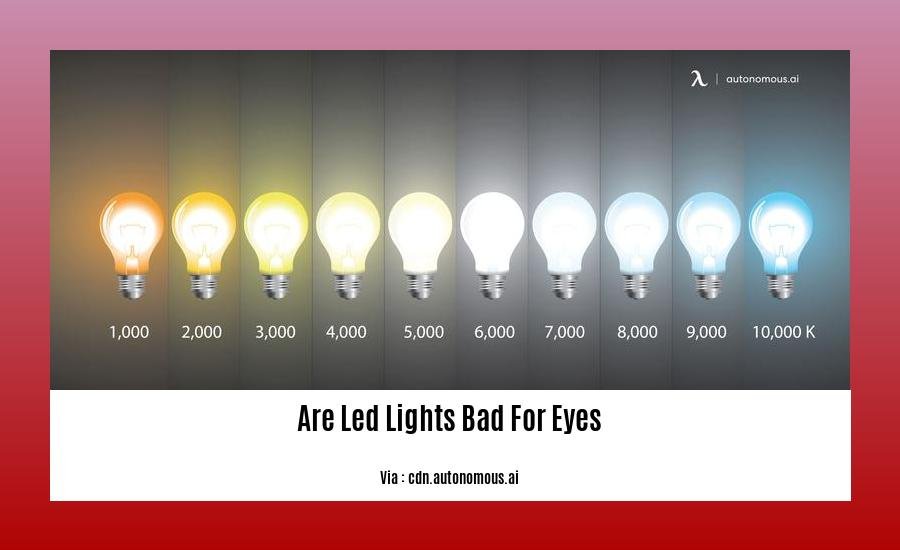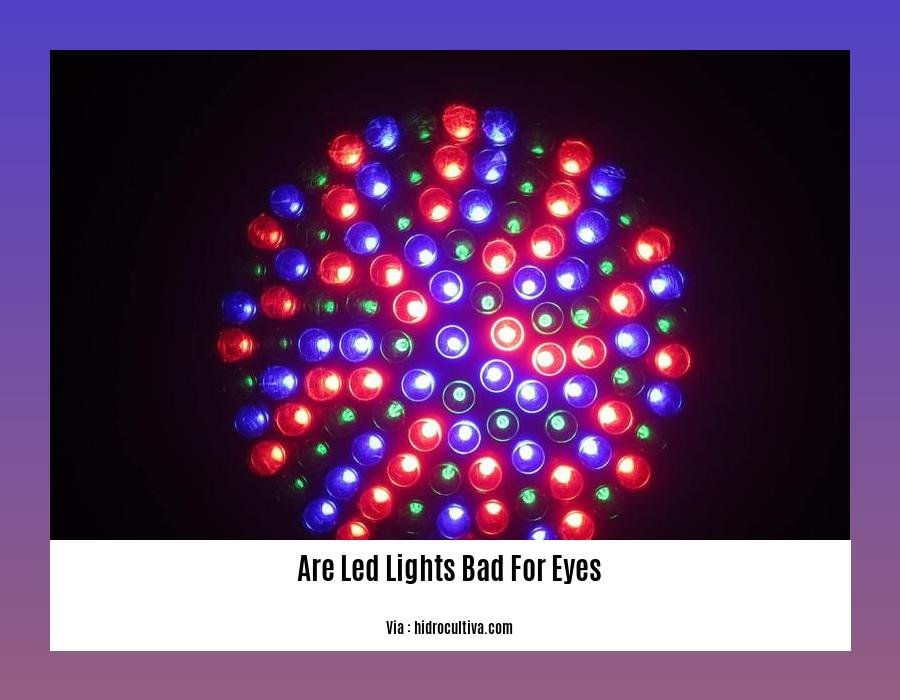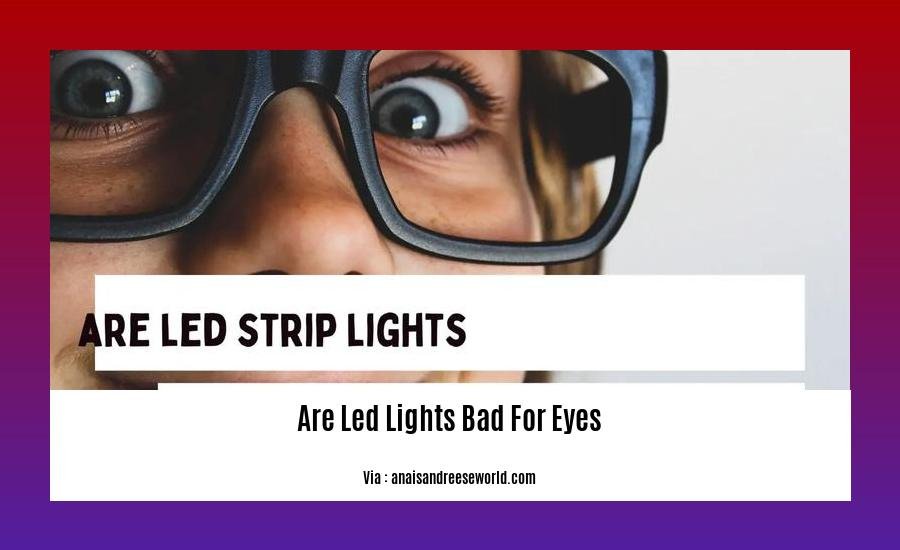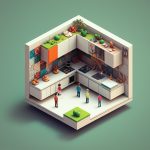Light-emitting diodes (LEDs) have revolutionized our world due to their energy efficiency, long lifespan, and various applications. However, concerns about their potential impact on eye health have emerged. Delve into our comprehensive guide [Are LED Lights Bad for Eyes? Uncovering the Truth] to discover scientific evidence regarding this topic. Explore the potential harmful effects of LED lights on our eyes and uncover practical measures to protect your vision. Learn the differences between various light sources and their impact on eye health, equipping you with informed choices for your lighting needs.
Key Takeaways:
-
LED lights emit blue light, which can potentially harm the retina.
-
Long-term exposure to LED lights can lead to irreversible damage to the retina.
-
LED lights, however, lack ultraviolet rays, which are more detrimental than blue light.
-
Blue light is naturally present in sunlight.
-
LED lights are comparable in safety to other modern light sources.
-
LED lights are utilized in skin and other health therapies due to their lack of ultraviolet rays.
Are LED Lights Bad for Eyes?

There’s a lot of buzz these days about the potential dangers of LED lights for our eyes. Some people claim that these lights can cause eye strain, headaches, and even permanent damage to the retina. But what’s the truth? Are LED lights really bad for your eyes?
The Science Behind LED Lights
LED (light-emitting diode) lights are a type of solid-state lighting that uses semiconductors to emit light. They’re much more energy-efficient than traditional incandescent bulbs, and they last a lot longer. LED lights also produce very little heat.
Potential Risks of LED Lights
One of the main concerns about LED lights is that they emit blue light. Blue light is a type of high-energy visible light that can penetrate deep into the eye and reach the retina. Studies have shown that blue light can damage the retina and lead to age-related macular degeneration (AMD), a leading cause of blindness.
Another concern about LED lights is that they can cause eye strain. This is because LED lights often flicker, which can be distracting and fatiguing for the eyes.
Are LED Lights Safe?
So, are LED lights bad for your eyes? The answer is: it depends.
- The amount of blue light emitted by LED lights varies depending on the type of light. Some LED lights emit more blue light than others.
- The amount of time you spend exposed to LED lights also matters. The longer you’re exposed to blue light, the greater your risk of eye damage.
- Your age and overall health can also affect your risk of eye damage from LED lights. People who are older or who have certain health conditions, such as diabetes, are at higher risk.
How to Protect Your Eyes from LED Lights
If you’re concerned about the potential dangers of LED lights, there are some things you can do to protect your eyes:
- Choose LED lights that emit less blue light. Look for lights that have a warm color temperature (2,700-3,000 Kelvin).
- Limit your exposure to LED lights. Take breaks from screens and other devices that emit blue light.
- Use blue light-blocking glasses. These glasses can help to filter out blue light from LED lights.
Talk to Your Doctor
If you have any concerns about LED lights and your eye health, talk to your doctor. They can help you assess your risk of eye damage and recommend ways to protect your eyes.
Overall, LED lights are generally safe for most people. However, it’s important to be aware of the potential risks and to take steps to protect your eyes.
- There are a variety of plans for a 2 BHK flat, from more modern to traditional, you’ll definitely find a 2 BHK flat plan design that suits you.
- Our 2 BHK house plans cover a wide range of layouts and sizes to help you find the perfect fit for your needs, browse through our collection of 2 BHK house plan designs now.
- With various room configurations, you can find the perfect 4-room BTO size for your family’s needs, explore our wide selection of 4-room BTO size options.
- For design inspiration, you can have a look at our 4-room house design in Nepal with price.
4 Measures to Protect Our Eyes

Artificial lighting has become an integral part of our modern lives, but concerns have been raised about the potential impact of LED lights on eye health. While some studies have suggested that LED lights may emit harmful blue light, it’s crucial to understand the facts and take proactive steps to protect our eyes.
Key Takeaways:
-
LED lights emit blue light, which can potentially damage the retina.
-
Excessive exposure to blue light can disrupt sleep patterns and circadian rhythms.
-
Certain measures can be taken to minimize the impact of LED lights on our eyes.
The Blue Light Conundrum:
LED lights emit significant amounts of blue light, a portion of the visible light spectrum that can reach the retina and potentially cause damage. Over time, this exposure may contribute to age-related macular degeneration (AMD), a leading cause of vision loss.
Sleep Disturbances:
LED lights can also interfere with our sleep patterns. Blue light exposure suppresses the production of melatonin, a hormone that promotes sleep. As a result, spending too much time in front of LED-lit screens before bedtime can disrupt our circadian rhythm and make it harder to fall asleep.
Protective Measures:
Despite these concerns, we can take steps to protect our eyes from the potential risks of LED lights. Here are four practical measures to consider:
1. Limit Screen Time:
Reduce your overall screen time, especially before bedtime. Avoid using electronic devices for at least 30 minutes before going to sleep.
2. Blue Light Filters:
Utilize blue light filters on your devices. These filters can be found in screen protector films, software programs, and even eyeglasses.
3. Blue Light-Blocking Glasses:
Consider wearing blue light-blocking glasses while using digital devices or working in areas with bright LED lighting. These glasses can help reduce blue light exposure and protect your eyes.
4. Choose Warm White LEDs:
When choosing LED lights for your home or workspace, opt for warm white LEDs instead of cool white LEDs. Warm white LEDs emit less blue light.
Conclusion:
While LED lights may pose some potential risks to our eye health, we can effectively minimize these risks by implementing simple protective measures. By limiting screen time, using blue light filters, wearing blue light-blocking glasses, and choosing warm white LEDs, we can safeguard our eyes and maintain optimal vision.
Citation:
Are LED Lights Bad for Eyes? Uncovering the Truth
Which Lights Are Good For Eyes?
Are LED lights bad for eyes? It’s a question that’s been buzzing around the digital world, leaving many concerned about the impact of modern lighting on their precious vision. To set the record straight, let’s dive into the world of eye health and LED lights, exploring the truth behind these claims.
Key Takeaways:
- Blue Light Blues: LED lights emit blue light, which can potentially cause damage to the retina, increasing the risk of age-related macular degeneration (AMD).
- Circadian Rhythm Disruption: Excessive exposure to blue light may disrupt sleep patterns and circadian rhythms, affecting overall well-being.
- Screen Time and Melatonin: Prolonged screen time before bedtime can hinder sleep due to the suppression of melatonin, the hormone that regulates our sleep-wake cycle.
- Protective Measures: We can minimize the impact of LED lights on eye health by limiting screen time, employing blue light filters, wearing blue light-blocking glasses, and choosing warm white LEDs in our living spaces.
Understanding the Risks: Blue Light and the Eyes
The primary concern surrounding LED lights is their emission of blue light. Blue light is a high-energy visible light that can penetrate the cornea and lens, reaching the retina at the back of the eye. While blue light is naturally present in sunlight, excessive exposure may pose risks to our vision.
Blue Light and Age-Related Macular Degeneration (AMD)
Age-related macular degeneration (AMD) is the leading cause of vision loss in older adults. Studies suggest that prolonged exposure to blue light may contribute to the development and progression of AMD, damaging the light-sensitive cells in the macula, the central part of the retina responsible for sharp central vision.
Blue Light and Circadian Rhythm Disruption
Our eyes contain special cells called retinal ganglion cells that are sensitive to light. These cells play a crucial role in regulating our circadian rhythm, the natural sleep-wake cycle. Excessive exposure to blue light, especially in the evening, can interfere with the production of melatonin, a hormone that promotes sleep. When melatonin production is disrupted, it can lead to difficulty falling asleep and staying asleep.
Protective Measures: Safeguarding Your Eyes from LED Lights
While LED lights have potential risks, there are several steps we can take to minimize their impact on our eye health:
- Screen Time Management: Limit overall screen time, particularly before bedtime. Take regular breaks from screen use to give your eyes a chance to rest.
- Blue Light Filters: Many electronic devices now come with built-in blue light filters. Utilize these filters to reduce your exposure to blue light during screen time.
- Blue Light-Blocking Glasses: Consider wearing blue light-blocking glasses specifically designed to filter out harmful blue light. These glasses are particularly beneficial for individuals who spend prolonged periods in front of screens.
- Warm White LEDs: Opt for warm white LEDs in your home and workspace lighting. Warm white LEDs emit less blue light compared to cool white or daylight LEDs.
Conclusion: Striking a Balance
While LED lights have been the subject of some concerns regarding their potential impact on eye health, it’s important to remember that not all LED lights are created equal. By implementing preventive measures, such as limiting screen time, utilizing blue light filters, and choosing warm white LEDs, we can minimize the risks and enjoy the benefits of LED lighting without compromising our eye health.
Sources:
- Harvard Health Publishing: Blue Light and Eye Health
- American Academy of Ophthalmology: How to Protect Your Eyes from Blue Light
FAQ
Q1: Can LED lights cause eye damage?
A1: LED lights emit high levels of blue light, which can have a negative impact on eye health. Blue light exposure can lead to eye strain, fatigue, and even macular degeneration.
Q2: What are some ways to protect my eyes from LED lights?
A2: To protect your eyes from the harmful effects of LED lights, you can use blue light filters on your electronic devices, wear blue light-blocking glasses, choose warm white LED lights, and maintain good overall eye health.
Q3: How do LED lights affect sleep?
A3: LED lights can interfere with regular sleep patterns by suppressing the production of melatonin, a hormone that helps regulate sleep. Exposure to LED lights in the evening can make it harder to fall asleep and stay asleep.
Q4: Are there any specific LED lights that are better for your eyes?
A4: LED lights with lower color temperatures (warm white) are less likely to cause eye strain and fatigue. You should also avoid direct exposure to high-intensity LED lights for extended periods.
Q5: What are some alternatives to LED lights?
A5: If you are concerned about the potential harmful effects of LED lights, you can choose other lighting options such as incandescent bulbs, halogen bulbs, or compact fluorescent lights (CFLs).
- White Kitchen Backsplash Ideas For a Timeless, Stylish Update - November 15, 2025
- Contemporary White Kitchen Backsplash: Style and Design Ideas - November 14, 2025
- Decorative Backsplash Ideas: Colorful Kitchen Transformations for Your Home - November 13, 2025










